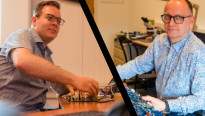
Krijn van Baren and Jan Bert Kuipers are the “lab technicians” of the Global Organ Group. All of the technical piping and wiring in Johannus organs has at some point passed through their figurative test tubes and pipettes, and they enjoy their work immensely. “But the open factory days are the best part of all. During these days we meet customers whose musical imagination has been awakened by our organs.”
The Dutch branch of the Global Organ Group Research & Development department is staffed by nine people, including two Hardware Engineers, five Software Engineers, one Hardware and Software Engineer, and one Compliance Engineer. Hardware Engineer Krijn boarded the Johannus train in 1990. “This is only my second job ever. After I finished secondary technical school, I worked briefly and intermittently with another company before coming to Johannus.”
Jan Bert works on both hardware and software. Following his studies at tertiary technical school (in automotive engineering), he worked for a chip manufacturer and then a project agency, finally arriving in Ede in 2018. “That was quite a switch,” he says. “I called the Global Organ Group one day and said to them: I’m looking for work that combines audio engineering and software and hardware development, and I love what you do.” The rest is history.
Translating formulas into software
The work that Krijn and Jan Bert do is a rather complex blend of the ingredients that Jan Bert mentioned in his phone call to his then-prospective employer. In practice, this involves translating complicated formulas (if a = x, then b = y, and so on) into intelligent software programmed on hardware that they have designed themselves. Krijn: “We use a PCB design program to draw the schematics for printed circuit boards from scratch. To put it in simple terms, we connect wires to bases until everything fits together correctly. Once we’ve completed the schematic layout, it’s sent to the factory where ‘bare’ circuit boards are made. A company in the Netherlands assembles the circuit boards. All the components are added exactly as we have prescribed, and what we end up receiving here is the ready-made motherboard.”
The technical-musical heart of the organ
When it comes down to it, the Global Organ Group’s goal – to come as close as possible to the genuine pipe organ sound – is a musical task that is achieved by technical means. Everything necessary to accomplish this is conceived, designed, tested, refined, stabilized, accelerated and optimized at R&D.
Physically speaking, the central focus is the motherboard, which is the technical-musical heart of all organs. This is the place where the creativity and virtuosity of the organist is first converted into digital instructions for the individual functionalities, which then convert them into analog sounds that are intelligible to the human ear. This all takes place within a split second. “Just a few milliseconds,” says Jan Bert. “There is a few thousandths of a second between the moment that you press a key and then hear the sound. Practically speaking, that’s real time.”
Ongoing improvements to this motherboard are part of the core work carried out by R&D. There have been great leaps forward over the past few decades, says Krijn. “In the time that has elapsed since the first digital organ was made, to the series we’re producing today, there have been six major technological developments. Smaller changes have also taken place in the meantime. For example, when particular components on the circuit boards are no longer being produced, you have to come up with new solutions.” Jan Bert: “The world famous Johannus sound is a result of all the choices that have been made here over the years. That involved the combination of many factors, such as the convolution reverb, the sampling, the audio output, the extremely high-quality amplifiers and speakers... We want to be the cream of the crop on all fronts.”
Music is emotion
How do the new features on Global Organ Group organs come about? “Most of the time, we receive questions from the market,” explains Krijn. “We then get started on calculating, designing and testing.” “But,” adds Jan Bert, “sometimes it’s the other way around too. Our technical director comes to us with an idea and asks if we can figure out how to make it work.”
No matter where the inspiration comes from, the Global Organ Group laboratory inventions ultimately have to be in service of the music, and music is experience and emotion. Krijn and Jan Bert can converse on this subject too – as well as being technically innovative, they are also musical... just not on the organ. Krijn is a member of Muziekvereniging Crescendo in Elst, Utrecht, and plays a variety of music genres on his saxophone. As a member of a religious community in Arnhem, Jan Bert plays the piano and keyboard and accompanies their church services.
Having a musical background is not essential for their research and innovation, but it certainly isn’t a hindrance either, says Jan Bert. “If I’ve developed something new, I get behind the manuals right away to try it out. Because I understand the musical experience, I know exactly how something should sound.” Krijn: “Sometimes we can lose ourselves in all kinds of technical details. For that reason, I really enjoy our open factory days. We meet customers there whose musical imagination has been awakened by our organs, and that makes it really come to life for us too.”
He still remembers very well the moment that his daughters performed a piece of music with an organist on the giant Monarke in the Global Organ Group’s Feike Asma Hall. “It was to celebrate my 25th work anniversary. One daughter played the saxophone and the other the bugle, accompanying the organ that I had helped to develop. That was a very moving moment, a very intense merging of the technics with the emotion.”